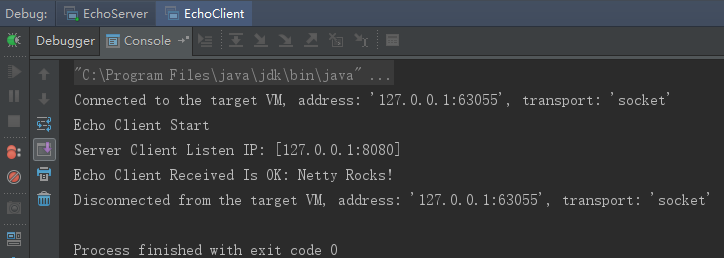1. 老规矩, 引入我们喜闻乐见的maven依赖
1 <dependency> 2 <groupId>io.netty</groupId> 3 <artifactId>netty-all</artifactId> 4 <version>4.1.6.Final</version> 5 </dependency>
2. 服务端
2.1: 服务端引导类:
1 public class EchoServer { 2 3 private int port; 4 5 private EchoServer(int port) { 6 this.port = port; 7 } 8 9 private void start() throws Exception { 10 System.out.println("Echo Server Start"); 11 EventLoopGroup group = new NioEventLoopGroup(); 12 try { 13 ServerBootstrap b = new ServerBootstrap(); 14 b.group(group) 15 .channel(NioServerSocketChannel.class) 16 .localAddress(new InetSocketAddress(port)) 17 .childHandler(new ChannelInitializer<SocketChannel>() { 18 @Override 19 public void initChannel(SocketChannel ch) throws Exception { 20 ch.pipeline().addLast(new EchoOutboundHandler1()); 21 ch.pipeline().addLast(new EchoOutboundHandler2()); 22 23 ch.pipeline().addLast(new EchoInboundHandler1()); 24 ch.pipeline().addLast(new EchoInboundHandler2()); 25 } 26 }); 27 ChannelFuture f = b.bind().sync(); 28 System.out.println("Server Start Listen At: " + port); 29 f.channel().closeFuture().sync(); 30 } finally { 31 group.shutdownGracefully(); 32 } 33 } 34 35 public static void main(String[] args) throws Exception { 36 int port; 37 if (args.length > 0) { 38 port = Integer.parseInt(args[0]); 39 } else { 40 port = 8080; 41 } 42 new EchoServer(port).start(); 43 } 44 }
2.2 EchoOutboundHandler1
1 public class EchoInboundHandler1 extends ChannelInboundHandlerAdapter { 2 3 @Override 4 public void channelRead(ChannelHandlerContext ctx, Object msg) { 5 // 读取msg中的数据 6 ByteBuf result = (ByteBuf) msg; 7 byte[] bytes = new byte[result.readableBytes()]; 8 result.readBytes(bytes); 9 String resultStr = new String(bytes); 10 System.out.println("Server Received: " + resultStr + ": Inbound 1 Is OK"); 11 12 // 处理完msg中的数据后往msg中重新存放新的数据继续传递 13 result.writeBytes(resultStr.getBytes()); 14 ctx.fireChannelRead(result); 15 } 16 17 }
2.3 EchoInboundHandler2
1 public class EchoInboundHandler2 extends ChannelInboundHandlerAdapter { 2 3 @Override 4 public void channelRead(ChannelHandlerContext ctx, Object msg) { 5 // 读取msg中的数据 6 ByteBuf result = (ByteBuf) msg; 7 byte[] bytes = new byte[result.readableBytes()]; 8 result.readBytes(bytes); 9 String resultStr = new String(bytes); 10 System.out.println("Server Received: " + resultStr + ": Inbound 2 Is OK"); 11 12 // 处理完msg中的数据后往msg中重新存放新的数据继续传递 13 result.writeBytes(resultStr.getBytes()); 14 ctx.write(result); 15 } 16 17 }
2.4 EchoOutboundHandler2
1 public class EchoOutboundHandler2 extends ChannelOutboundHandlerAdapter { 2 3 @Override 4 public void write(ChannelHandlerContext ctx, Object msg, ChannelPromise promise) throws Exception { 5 // 读取msg中的数据 6 ByteBuf result = (ByteBuf) msg; 7 byte[] bytes = new byte[result.readableBytes()]; 8 result.readBytes(bytes); 9 String resultStr = new String(bytes); 10 System.out.println("Server Received: " + resultStr + ": Outbound 2 Is OK"); 11 12 // 处理完msg中的数据后往msg中重新存放新的数据继续传递 13 result.writeBytes(resultStr.getBytes()); 14 ctx.write(result); 15 } 16 }
2.5 EchoOutboundHandler1
1 public class EchoOutboundHandler1 extends ChannelOutboundHandlerAdapter { 2 3 @Override 4 public void write(ChannelHandlerContext ctx, Object msg, ChannelPromise promise) throws Exception { 5 // 读取msg中的数据 6 ByteBuf result = (ByteBuf) msg; 7 byte[] bytes = new byte[result.readableBytes()]; 8 result.readBytes(bytes); 9 String resultStr = new String(bytes); 10 System.out.println("Server Received: " + resultStr + ": Outbound 1 Is OK"); 11 12 // 处理完msg中的数据后往msg中重新存放新的数据继续传递 13 result.writeBytes(resultStr.getBytes()); 14 ctx.write(result); 15 ctx.flush(); 16 } 17 }
3. 客户端
1 public class EchoClient { 2 3 private String host; 4 private int port; 5 6 private EchoClient(String host, int port) { 7 this.host = host; 8 this.port = port; 9 } 10 11 private void start() throws Exception { 12 System.out.println("Echo Client Start"); 13 EventLoopGroup group = new NioEventLoopGroup(); 14 try { 15 Bootstrap b = new Bootstrap(); 16 b.group(group) 17 .channel(NioSocketChannel.class) 18 .remoteAddress(new InetSocketAddress(host, port)) 19 .handler(new ChannelInitializer<SocketChannel>() { 20 @Override 21 public void initChannel(SocketChannel ch) throws Exception { 22 ch.pipeline().addLast(new EchoClientHandler()); 23 } 24 }); 25 ChannelFuture f = b.connect().sync(); 26 System.out.println("Server Client Listen IP: [" + host + ":" + port + "]"); 27 f.channel().closeFuture().sync(); 28 } finally { 29 group.shutdownGracefully(); 30 } 31 } 32 33 public static void main(String[] args) throws Exception { 34 String host = "127.0.0.1"; 35 int port = 8080; 36 int len = 2; 37 if (args.length == len) { 38 host = args[0]; 39 port = Integer.parseInt(args[1]); 40 } 41 new EchoClient(host, port).start(); 42 } 43 44 }
1 public class EchoClientHandler extends ChannelInboundHandlerAdapter { 2 3 @Override 4 public void channelActive(ChannelHandlerContext ctx) { 5 ctx.writeAndFlush(Unpooled.copiedBuffer("Netty Rocks!", CharsetUtil.UTF_8)); 6 } 7 8 @Override 9 public void channelRead(ChannelHandlerContext ctx, Object msg) { 10 // 读取msg中的数据 11 ByteBuf result = (ByteBuf) msg; 12 byte[] bytes = new byte[result.readableBytes()]; 13 result.readBytes(bytes); 14 String resultStr = new String(bytes); 15 System.out.println("Echo Client Received Is OK: " + resultStr); 16 ctx.close(); 17 } 18 19 @Override 20 public void exceptionCaught(ChannelHandlerContext ctx, Throwable cause) { 21 cause.printStackTrace(); 22 ctx.close(); 23 } 24 }
4. 结果:
服务端:

客户端:

5. 注意事项:
5.1. ChannelInboundHandler之间的传递, 通过调用 ctx.fireChannelRead(msg) 实现; 调用ctx.write(msg) 将传递到ChannelOutboundHandler
5.2. ctx.write()方法执行后, 需要调用flush()方法才能令它立即执行
5.3. ChannelOutboundHandler 在注册的时候需要放在最后一个ChannelInboundHandler之前, 否则将无法传递到ChannelOutboundHandler